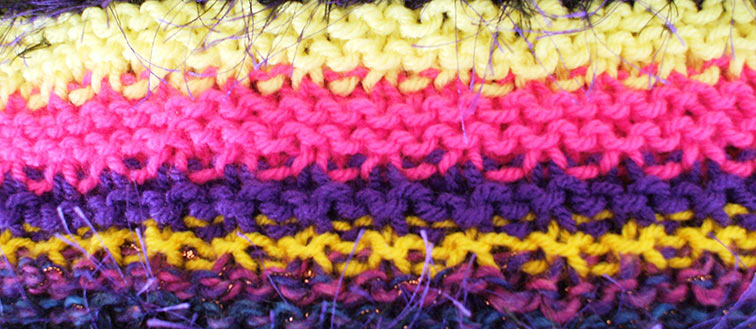Knitting a difference
A Crafting Change Together project
Lynn Bhania and Amanda Roberts - School of Education, University of Hertfordshire

The material presented in the journal is predominantly in written form. However, the on-line nature of the journal also facilitates the presentation of non-written modes of communication including art-based works and video.
We are keen to encourage the sharing of knowledge through these alternative modes.
The 'Knitting a difference' thought-piece below is provided in the form of both a video and of text with video extracts to cater for alternative reading and learning preferences.
Knitting a difference thought-piece in video format
Knitting a difference thought-piece in text format
Crafting Change Together (CCT) is a community development project which aims to support individuals and groups in using craft activities to bring about change. This change may benefit the individual or group, or may have wider benefits for a specific community of for society.
CCT is an umbrella for a variety of different activities. The medium of crafts is used to engage people of different ages, experiences and backgrounds to come to talk and learn together.
Why knitting?
Much of our current crafting focuses on knitting. A key aim for Crafting Change Together is the development of inter-generational understanding. Knitting is a traditional skill, currently back in fashion in the UK. The word is derived from knot and ultimately from the Old English cnyttan, to knot (Games 2006).
The learning of ancient skills and the handing down of histories from one generation to another can generate mutual respect as young and older people come to understand one another through communication in a non-threatening environment.
Knitting is reported to have other personal and social benefits. Gauntlett (2004) underlines the power of crafting in the development of the capacity for resilience in the complex world in which we now live, whilst Parker (2010) points out the transformative impact of crafting on a sense of self.
We are particularly interested in the impact of crafting on feelings of well-being and on the capacity for personal change. Our particular focus is on ways in which we can 'knit a difference'.
We have used two Crafting Change Together projects in this thought-piece to explore this focus.
The Purwell Primary School knitting project
The aims of this project were to create an opportunity for young and senior citizens to come together to learn new skills, or develop old ones.
We hoped this joint activity would result in a deeper inter-generational understanding and a sense of personal pride in what individuals managed to knit.
Senior citizens from the local community worked with us across a number of weeks to teach Year 6 pupils at Purwell Primary School in Hitchin to knit collaborative scarves.
Headteacher Richard Cano gave this evaluation of the project:


Evidence
Stories from the University of Hertfordshire School of Education 'Knit Club!'
Every Thursday from 5.00 to 6.30pm there is a drop in knitting session in the School of Education.
Staff, students and people from the local community are all welcome and the knitting experience varies from 60 years to none. Chocolates and fruit are provided.
We have been meeting for 5 months and numbers fluctuate from week to week between 4 and 20. In that short space of time many interesting stories have already been told.
T took her knitting with her on the train and the man across from her began to talk about knitting with her and eventually gave her his phone number.
S came to the group to help improve her English and knitted her granddaughter a hat for Christmas whilst telling us all about herself and her family.
N had a short spell in hospital and started a knitting club whilst she was in there, which is still going. She is knitting a big cushion cover.
C, D and U regularly bring their knitting or crochet to sit and wind down after a busy teaching day.
Ten undergraduate students from Shanghai University who were on a two week visit to the University of Hertfordshire learnt to knit at the first knit club and all took home a headband or scarf which they had completed at the second one.
W is a local couture designer who has learnt to knit and is now using her knitting in wonderfully original ways.
L taught himself to do Tunisian Knitting on YouTube and has knitted himself a scarf.
LL knits breasts for midwives, scarves for women's refuges and uteri to send to midwives in Ethiopia.
So what have we learned?
Riley et al.'s (2013) view of knitting as a vehicle for personal and social wellbeing has been underlined in these two knitting projects. People of all ages have clearly benefitted from knitting, learning and talking together.
Something changes slowly, week by week where people share their stories as they relax, talk and create works of art for themselves and others.
We look forward to continuing to explore the power of knitting to support personal and social change.
A quiet revolution is happening…
⇠ Read 'Because we're worth it...'Read 'Voices of children aged 10 and 11 revisited...' ⇢
References
- Games, A. (2006) Balderdash & Piffle: One Sandwich Short of a Dog's Dinner. BBC Books, London.
- Gauntlett, D. (2011) Making is connecting. Cambridge: Polity Press.
- Parker, R. (2010) The subversive stitch. Embroidery and the making of the feminine. London: I.B Tauris and Company.
- Riley, J., Corkhill, B. and Morris, C. (2013) 'The benefits of knitting for personal and social wellbeing in adulthood; findings from an international survey'. The British Journal of Occupational Therapy. 76 (2).
This project received support in 2013-14 from a Higher Education Social Enterprise Award from UnLtd and the Higher Education Funding Council for England, through the University of Hertfordshire.
To learn more about Crafting Change Together, visit our website: http://www.craftingchangetogether.org/
LINK 2015, vol. 1, issue 2 / Copyright 2015 University of Hertfordshire




